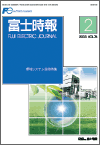Home > About Fuji Electric > Research & Development > Technical Intelligence > Fuji Electric Journal > Fuji Electric Journal
FUJI ELECTRIC JOURNAL 2003 Vol.76-No.2
 |
Environmental Technology |
Present Status and Trends of Environmental Preservation
Ginjiro Yanai, Masakazu Usui, Matsuru Umemoto
The socio-economic activities of mass production, mass consumption and mass waste disposal, combined with the unbalance in the autonomous circulation of the ecosystem are causing various disruptions to the environmental. As corrective measures, various laws have been passed and enacted. Fuji Electric has adopted a working philosophy based on the objectives of "contributing to society's prosperity," "striving to innovate," and "harmonization with nature," and is working on various technical developments to benefit the environment. This paper discusses the present status and Fuji's efforts concerning environmental technology, as well as the future outlook.
Fuji Recycle Plaza
Ryousuke Maruyama
Nowadays, no one will dispute the importance of the effective utilization of resources and the appropriate processing of disposal waste. However, the difficulty in resolving these issues cannot be denied either. Fuji Electric has been involved with these important and complex issues from early on and has accumulated a record of numerous successes. This paper introduces one such example of Fuji's efforts in response to these issues.
Wastewater Treatment System for Waste Landfill Sites
Kenichi Hanaoka, Hideki Kazumi
After waste material is recycled or treated with an intermediate process, it is disposed of at a landfill site. A wastewater treatment system is provided to ensure the quality of the water discharge from the site after rainwater or the like has seeped into the layer of landfilled waste. In recent years, water discharge sites have required highly refined treatment of the dioxins and salts contained in the discharge water. This paper describes an example installation of Fuji's wastewater treatment system and future challenges facing this technology.
Tracking Service for Waste Collection and Transportation
Kohichiroh Muneki, Narihide Yamada
The tracking service provided by Fuji Electric enables municipalities to easily realize a general waste collection and management system. Recently, local municipalities throughout Japan have increasingly been cooperating with their neighboring municipalities to jointly collect and process waste material as a form of regional processing. However, as a rule, each district has processed its own general waste. And even in this case of regional processing, the citizens of each local municipality are assessed a tax according to their amount of discharged waste. Consequently, there is demand for a system able to perform accurate tracking of transported waste and to identify its local municipality of origin. This paper will introduce Fuji's tracking service, which satisfies these requirements.
Development of a Solid Waste Ash Recycling System
Akimasa Yoshimoto, Michiru Fujita, Tadashi Kunitani
Solid waste ash is melted by an electric resistance furnace, then dioxins are decomposed at the high temperature of 1,400
RDF (refuse derived fuel) Incineration and Power Generation Facility in Mie Prefecture
Hideo Sasaki
RDF (refuse derived fuel) is solid fuel formed from combustible general waste that has been dried and then compressed. Compared to conventional electric power generation by direct incineration of refuse, RDF allows for easier transportation and storage, and achieves higher efficiency for power generation. This paper presents an overview, including the specifications, operation and maintenance, of the Mie RDF Incineration and Power Generation Facility that was supplied by Fuji Electric.
Development of Power Generation Technologies Using Biomass Derived Waste
Fuyuhiko Ishikawa, Tomohiro Sugiyama
Fuji Electric has been supplying phosphoric acid fuel cell (PAFC) generator systems applied for biogas. To extend the range of applications of PAFC, running tests were conducted using simulated low methane content biogas. The results confirmed that the system could be operated stably with simulated biogas having equivalent methane content of 40%. In addition, Fuji Electric is developing a methane fermentation system for kitchen waste. A bench-scale test unit is being operated using garbage from a factory cafeteria. It was also verified by field test that a wastewater treatment system for digested slurry could stably reduce total nitrogen content to below 60 mg/L.
Apparatus for Maintaining Residual Chlorine Concentration "Fukkatsu-kun"
Hisamichi Ishioka, Hiroshi Deno, Ikuo Myose
Fuji Electric Co., Ltd. has developed a residual chlorine concentration maintenance apparatus. (The trade name is "Fukkatsu-kun.") This apparatus provides safe and unattended sanitation control of a water tank such as at a school, public facility or housing complex by means of electrolysis without the use of added chemicals. The amount of effective chlorine that had been depleted is regenerated by electrolysis, utilizing chlorine ions contained in the water. Residual chlorine concentration levels can be maintained at 0.1 mg/L or greater with a tip hydrant. Controlling the residual chlorine concentration in a water supply facility enables us to prevent the occurrence of sterilization byproducts such as trihalomethanes.
Energy-saving Sludge Treatment
- Freeze/Thaw Dewatering System and Filter Thickener with Siphon Pipe System -
Mikimasa Yamaguchi, Nobuyuki Motoyama, Masayuki Fujishima
A freeze/thaw dewatering system is used to freeze and thaw watery sludge, transforming it into coarse particles and dewatering it to low water content, without the addition of chemicals. The dewatered sludge is granular and may be effectively utilized as soil or backfill by farmers. Energy savings are realized due to the decrease in sludge volume resulting from use of a siphon-type filter thickener and the operation of an absorption refrigerating machine that utilizes CGS exhaust heat. Because the siphon-type filter thickener is able to highly concentrate the sludge and has low energy consumption, it is positioned to contribute to the increased stability and efficiency of concentration tanks, hydro-extractors, digesters, etc. at water supply and sewerage processing facilities.

